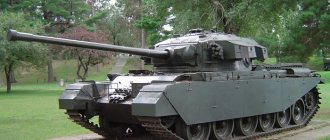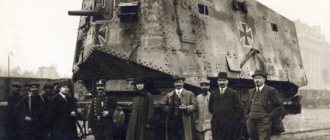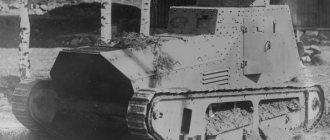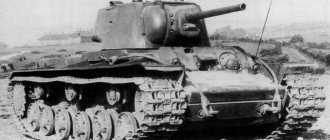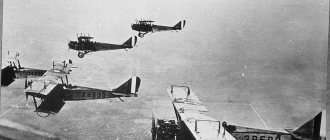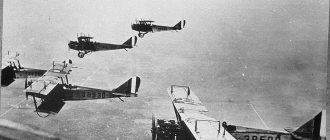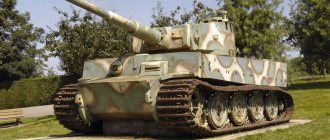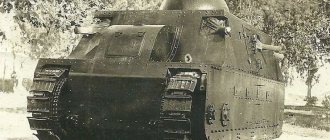From idea to creation
Not everyone knows that the idea of a tracked vehicle first appeared in Russia, back in 1878. In May 1915, tests began on Porokhovshchikov's armored vehicle called the All-Terrain Vehicle. Frankly speaking, it didn’t look much like a tank. Despite the armor and rotating turret with a machine gun, the vehicle was driven by one wide track and controlled by wheels on the sides. The cross-country ability turned out to be excellent.
In the same year, tests began on an extremely unusual Soviet tank designed by Lebedenko. It looked like a giant gun carriage with huge wheels that set it in motion. The designer believed that the tank would easily overcome trenches, holes, trees and other obstacles, however, this did not happen. The giant got stuck right during testing, after which it stood for many years, waiting to be sent for scrap.
Naval traditions and His Majesty's centipede
The first British tanks borrowed a lot from the navy: compasses, sponsons, even their sides were named not like people do - left and right - but in a nautical manner: starboard side ("starboard side") and port side ("port side").
Unofficially, the first tanks were nicknamed "Little Willie" and "Big Willie", aka "Mother".
The official name of the “Mother” was more magnificent - His Majesty’s Land Ship “Centipede” (“His Majesty’s Land Ship “Centipede”). It’s logical - since it’s a “ship,” it means it should be called like a ship, that is, with a naval prefix. By the way, even the gender of the noun passed on to the first tanks from ships. In documents from the First World War, tanks are often feminine: she, like ships.
Later, the prefix was completely abolished: the fleet is the fleet, and the British tank crews have their own pride. And the tanks began to be called simply Landship - the name stuck.
In addition to the prefix, the tanks had names that were invented by the commanders and crew. As a rule, the first letter of the name corresponded to the letter that designated the company. And, of course, names that were offensive to the royal family could not be used.
Otherwise, there was complete creative freedom: some practiced witticisms, like the crews of HMLS “We’re All Inside” and “The Flying Scotsman,” others named the tank after the name of the family estate (“Casa”); Biblical names (“Delilah”) or simply female names (“Dolly,” “Black Bessie”) were widely used.
The name of the Mark I tank is “HMLS OH, I SAY!!!”
Some names have funny stories associated with them. The stepdaughter of Stuart Hastie, commander of the D17 Dinnaken tank, recalled that the name of the combat vehicle appeared like this: after the first battles, a reporter approached Hastie and asked what the name of the tank was. Stuart either didn’t hear the question, or wanted to quickly get rid of the annoying newspaperman, so he answered: “Dinnaken,” that is, in Scots - “I don’t know.” Thus, an unexpected name found its way into the press, and at the same time into history.
In other countries, although the fleet did not influence tanks so noticeably, the tradition of giving names to combat vehicles was appreciated and picked up - with some local differences. The French, for example, gave names even to small Renault FT-17s, and the Germans preferred to call tanks with female names - “Anchen”, “Katie”, “Marianne” and so on. And the Germans named a couple of trophy “diamonds” in honor of the characters of a famous fairy tale: “Max” and “Moritz” (“Max and Moritz. The Story of Boys in Seven Tricks” - a work by the German poet-humorist Wilhelm Busch).
Renault FT-17 named "Le Tigre". French Tiger tank - long before it became fashionable among the gloomy Teutons
Tanks came to Russia already during the Civil War, but even here the tradition took root. Whites, as a rule, named tanks in honor of some military leaders - “General Kornilov”, “General Drozdovsky” - or gave neutral names: “Sphinx”, “Brown Bear”. Even slogans were used (“For United Russia”, “For Holy Rus'”), but less often.
But a distinctive feature of the names of the red tanks was excessive ideological overtones and slogans like “Freedom Fighter comrade. Lenin”, “Our answer to Chamberlain”, “Gift to Lloyd George” or “For Socialism”.
Mark V "Our answer to Chamberlain"
Stagnation
It seemed that USSR tanks would take leadership in the world, but this did not happen. The First World War took place without domestic vehicles; foreign ones were used in the Civil War. In 1918, there was a clear awareness of the need to develop and produce domestic tanks. Captured French Reno-FTs, shown at a parade in Moscow, were copied at the Krasnoye Sormovo plant, creating the first example on August 31, 1920 under the name Tank M.
In 1925, production of the MC-1 began, which was distinguished by its low price and copied from the Fiat-3000. Other models were also developed. Higher in price, more difficult to manufacture, but without significant advantages.
The vicious time of imitation began, when foreign models were taken as the basis for Soviet tanks. Vickers Mk became T-26, Carden Loyd Mk VI became T-27, Vickers Medium Mark III became T-28, Independent became T-35.
A series of high-speed BTs was created on the basis of the Christie tank. They had excellent mobility due to the possibility of wheel travel, but were extremely unreliable.
New weapons of the First World War
The British government, having received information about the success of the new weapon, intensified work on the creation and production of tanks.
During the First World War, England produced more than 3,000 tanks of 13 modifications.
France did not lag behind its Entente allies. It was she who owned the most successful Renault FT tank at that time. It was armed with a machine gun (from 1917 - a cannon). It weighed 6 tons, had a crew of 2 people, and had a speed of 9.6 km. The Renault FT became the prototype for many other tanks and was in service with the French army until the early 30s.
As for other countries that later became tank manufacturers (Russia, Germany, the USA), their contribution to the creation of new weapons during the First World War came down to attempts to modify English and French models purchased or captured in battle.
USSR tanks of World War II
The USSR entered World War II with a huge tank army, which turned out to be powerless against the much smaller, but experienced, organized and modern German one.
But the imitation stopped and truly unique Soviet tanks began to appear. The heavy KV was practically invulnerable and could single-handedly hold off numerous enemy forces, but its mobility and reliability left much to be desired. The T-34, which appeared later, was a revolution in tank building, combining mobility, firepower and sloped armor. At the same time, the tank was cheap and easy to manufacture. Yes, at first there were many shortcomings, the disgusting quality of the components, and towards the end of the war there was not enough firepower and armor, but manufacturability, mass production and a set of characteristics left all competitors far behind.
The heavy IS-2, which appeared at the end of the war, fought on equal terms with the best examples of Wehrmacht equipment, and the IS-3, which did not have time to fight, was head and shoulders above all its contemporaries. The decline of heavy tanks was approaching, but the USSR managed to create the IS-7 and Object 279, which are surprising even now.
Great Britain
The work of companies producing tanks in the UK was greatly influenced by the debate that developed in the military department between supporters of cruising (fast, light, maneuverable, but easily vulnerable and weakly armed) tanks and infantry (heavy, with good armor protection and strong weapons, but insufficiently maneuverable) machines.
The victorious supporters of the first, but incorrect, option led to the fact that by the beginning of the Second World War, the British Army had mainly light and cruising tanks in service.
Things were no better for another manufacturer of the first armored vehicles. If the British gave the tank crews of the British Army a Vickers 6t instead of a good tank (the license for its production was sold) They massively supplied the cheap Carden-Lloyd wedge, but the French continuously tried to improve the already well-known Renault FT.
As a result, France approached the Second World War with an army equipped mainly with light tanks and old Renaults.
Original names
The names of tanks during and after World War II were interesting. They usually popularized military leaders and other famous personalities. The American M4 Sherman has become the most popular in the United States and its allies. He glorified the famous General William Sherman. But in England, the Comet tank was considered famous, which effectively fought German vehicles and had many similarities with the Sherman and Firefly.
The post-war period introduced us to improved Americans: the M26 Pershing, named after General John Pershing, and the M46 Patton, also called General Patton. The British presented a medium tank with the original name "Centurion". This tracked vehicle was replaced in 1960 by the “Chieftain” (translated from English as “leader”).
Over time, designers began to try to make each tank specialized. Therefore, one of the reconnaissance vehicles was the M41 Walker Bulldog, also named after the general. It was designed after the war to replace the famous “Chaffee” or “General Chaffee”. As practice shows, in most cases, tanks during the Second World War and after it were named after great generals and those who made a huge contribution to the fighting. This trend was especially popular among the British.
Fast as lightning
Another, no less legendary, tank is the BT-7. This is also an abbreviation. It means "fast tank". He made his debut on the battlefield against Japan in 1938. He gained fame and success a year later in Mongolia. Then, in the steppe, the BT-7 was able to fully express itself, and its speed played into the hands of the soldiers. Until 1942, this machine was not inferior to its opponents and was used in the war. From that moment on, the armored tank began to be used much less, as stronger models appeared.
Modern exhibits
After World War II, designers analyzed the experience of combat operations and began to develop even more powerful and durable vehicles. The first of these attempts was the T-54. He served already in the second half of the 20th century. And a few years later it was upgraded to version 55. This tracked vehicle was so popular that it served until the beginning of the 21st century.
The names of Russian tanks have never had any special variants. Each of them had only a serial number. The T-72 was a later project. The tank was designed in 1973 and began to be actively used 10 years later. He served in Lebanon and the Middle East, and in 2008 he conducted a successful operation in Tskhinvali. In the early 90s it was improved - the T-90 was released.
Fear for the Germans
But the names of the KV series tanks were associated with the famous Klim Voroshilov, who became famous for his political activities. In 1941, the KV-1 became a real monster for the German troops. He held off the division for two days, and documents found indicated that the vehicle received 14 direct hits from a 50-mm gun. However, no damage was found on it - only small dents. And yet, two days later, the Nazis used cunning to damage the armored vehicle and destroy the KV-1. Their number during World War II was not large due to the fact that the state could not find funds for fuel and repairs.
First attempts
Together with the French and British, Russia also began to design a tracked vehicle. The son of the world famous Dmitry Mendeleev was the founder of this business. Vasily Dmitrievich developed a project for a ground combat vehicle. The next attempt was interesting designs. The names of Russian tanks of this time were particularly original: “Russian all-terrain vehicle” and “Tsar Tank”. These machines appeared in only one copy, as they were somewhat unsuccessful attempts. The government tried to track the projects of other countries in order to create its own, more advanced, military transport.
In addition to unsuccessful decisions, since 1917 they began to produce better cars from the Rybinsk plant. In most cases, the names of Soviet tanks began to appear thanks to the founders of the vehicles. So, Gulkevich’s armored tractor was released. In order not to slow down the process of improving the army, Russia decided to ask for help from France, from which it acquired several combat vehicles.
Combat "Joseph Stalin"
The world knows another victorious, powerful series of tracked vehicles. The names of Russian IS tanks were dedicated to Joseph Stalin. TTs were created specifically to break through enemy positions. Therefore, everyone coped with the task. IS-2 was the most popular among all ISs. In a couple of days, he was able to defeat 17 enemy vehicles and successfully broke through the defenses to Konigsberg and Berlin. The tracked vehicle served Russian weapons until 1995.
Legendary light tank
Over time, the names of tanks began to change to shorter ones. Thus, the first combat vehicle, which began to be widely distributed, was called MS-1. This abbreviation stood for “small escort tank.” It was first heard in the late 20s of the 20th century. In total, this LT numbered 960 copies. Appeared in battle in 1929. Then the tank managed to scare away all the Chinese infantry. There is a possibility that the MS-1 served the army during the Great Patriotic War.
